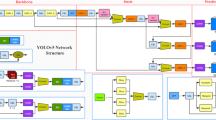Abstract
Bus passenger re-identification is a special case of person re-identification, which aims to establish identity correspondence between the front door camera and the back door camera. In bus environment,it is hard to capture the full body of the passengers. So this paper proposes a bus passenger re-identification dataset,which contains 97,136 head images of 1,720 passengers obtained from hundreds of thousands of video frames with different lighting and perspectives. We also provide a evaluation applied to the dataset based on deep learning and triplet loss. After data augmentation,using ResNet with trihard loss as benchmark network and pre-training on pedestrian re-identification dataset Market-1501, we achieve mAP accuracy of 55.79% and Rank-1 accuracy of 67.91% on passenger re-identification dataset.









Similar content being viewed by others
References
Chen W, Chen X, Zhang J, Huang K (2017) Beyond triplet loss: a deep quadruplet network for person re-identification. In: Proceedings of the IEEE Conference on Computer Vision and Pattern Recognition, pp 403–412
Cheng D, Gong Y, Zhou S, Wang J, Zheng N (2016) Person re-identification by multi-channel parts-based cnn with improved triplet loss function. Computer vision & pattern recognition
Dong H, Lu P, Zhong S, Liu C, Ji Y, Gong S (2018) Person re-identification by enhanced local maximal occurrence representation and generalized similarity metric learning. Neurocomputing:S0925231218304296
Geng M, Wang Y, Xiang T, Tian Y (2016) Deep transfer learning for person re-identification, arXiv:1611.05244
Hadsell R, Chopra S, LeCun Y (2006) Dimensionality reduction by learning an invariant mapping. In: 2006 IEEE Computer Society Conference on Computer Vision and Pattern Recognition (CVPR’06), vol 2. IEEE, pp 1735–1742
Hermans A, Beyer L, Leibe B (2017) In defense of the triplet loss for person re-identification, arXiv:1703.07737
Hou R, Ma B, Chang H, Gu X, Shan S, Chen X (2019) Interaction-and-aggregation network for person re-identification. In: Proceedings of the IEEE Conference on Computer Vision and Pattern Recognition, pp 9317–9326
Koestinger M, Hirzer M, Wohlhart P, Roth PM, Bischof H (2012) Large scale metric learning from equivalence constraints. In: 2012 IEEE Conference on Computer Vision and Pattern Recognition. IEEE, pp 2288–2295
Lin Y, Zheng L, Zheng Z, Wu Y, Hu Z, Yan C, Yang Y (2019) Improving person re-identification by attribute and identity learning. Pattern Recogn 95:151–161
Schroff F, Kalenichenko D, Philbin J (2015) Facenet: A unified embedding for face recognition and clustering. In: Proceedings of the IEEE conference on computer vision and pattern recognition, pp 815–823
Sun Y, Zheng L, Yang Y, Tian Q, Wang S (2018) Beyond part models: Person retrieval with refined part pooling (and a strong convolutional baseline). In: Proceedings of the European Conference on Computer Vision (ECCV), pp 480–496
Wang G, Yuan Y, Chen X, Li J, Zhou X (2018) Learning discriminative features with multiple granularities for person re-identification. In: Proceedings of the 26th ACM international conference on Multimedia, pp 274–282
Weinberger KQ, Saul LK (2009) Distance metric learning for large margin nearest neighbor classification. J Mach Learn Res 10:207–244
Zhang X, Luo H, Fan X, Xiang W, Sun Y, Xiao Q, Jiang W, Zhang C, Sun J (2017) Alignedreid: Surpassing human-level performance in person re-identification, arXiv:1711.08184
Zheng L, Shen L, Tian L, Wang S, Wang J, Tian Q (2015) Scalable person re-identification: A benchmark. In: Proceedings of the IEEE International Conference on Computer Vision, pp 1116–1124
Zheng L, Yang Y, Hauptmann AG (2016) Person re-identification: Past, present and future, arXiv:1610.02984
Funding
This research has been supported by National Natural Science Foundation of China (U1509207, 61572357and 61872270). Natural Science Foundation of Tianjin (18JCYBJC85500), Tianjin Science and Technology Project(18ZXZNGX00150).
Author information
Authors and Affiliations
Corresponding author
Additional information
Publisher’s note
Springer Nature remains neutral with regard to jurisdictional claims in published maps and institutional affiliations.
Rights and permissions
About this article
Cite this article
Guo, J., Xue, Y., Cai, J. et al. A bus passenger re-identification dataset and a deep learning baseline using triplet embedding. Multimed Tools Appl 80, 16425–16440 (2021). https://doi.org/10.1007/s11042-020-08944-0
Received:
Revised:
Accepted:
Published:
Issue Date:
DOI: https://doi.org/10.1007/s11042-020-08944-0




